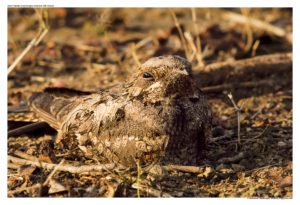
Jungle Nightjar Caprimulgus indicus
Etymology:
- Caprimulgus : Latin word capra – goat; mulgere –to milk . The nightjar were assumed to drink goats milk and injure the goats
- Indicus : From India
Vernacular Names:Hindi: BhartiyaJungliChapka, Dabchiri, Dabnak, Pun: Janglinehrni, Bhil: Kapoo, Lepcha: Tamor, Naga: Wapatshai, Cachar: Dao chuk, Guj: Vanachhapo, Van dasharadhiyu, Te: Mobbu pitta, Ta: Padukaikuruvi, Mal: Ra chuckoo, Sinh: Bin bassa, Mar: Ranratwa
Distribution in India: Resident of South and Western Peninsular India , Bihar, Orissa and Summer visitor in Rajasthan, Madhya Pradesh and Gujarat.
Description: Size of 21·5–24 cm; weight of male 60–108 g, weight of female 65–92 g. It is sexually dimorphic. The upperparts are greyish brown streaked blackish brown, broadly so on crown; indistinct pale buff or tawny-buff nuchal collar; lesser coverts are brown, speckled greyish white, buff or tawny; rest of wing-coverts are greyish brown, boldly spotted greyish white, pale buff or pale tawny with spots distinctly smudged or vermiculated brown. The scapulars are blackish brown, broadly edged greyish white vermiculated brown. It has buffish-white submoustachial stripe; large white patch on either side of lower throat; underparts are greyish brown, finely barred greyish-brown or pale buff, becoming buff barred brown on belly and flanks. The male has four outer primaries with large white spot with inner web only on outermost one, and white tips to all but central pair of tail feathers. The female has tawny wing spots and brownish-white or brownish-buff tips to tail feathers. The Iris is dark brown, bill is brownish or blackish, legs and feet are brownish. The immature is similar to adult female.
Habitat: It is found in forest, woods and wooded country, in open woodland, deciduous, pine and mixed bamboo forest, glades and thick brush jungle; also open scrubland, farmland and cultivation, mandarin orange orchards, Eucalyptus and teak plantations. .It is found from sea-level up to 2100 m.
Food habits: It eats moths, beetles, bugs, flying ants, cicadas, grasshoppers, locusts and small wasps. The foraging flight is extremely agile and buoyant. It hunts close to ground in glades and clearings, or high up over trees, either in sallies from perches or in continuous flights. It also feeds on insects attracted to artificial lights.
Breeding habits: They breed in Feb–May in India, Feb to Aug in South India and Feb–Jul in Sri Lanka. The nest-site is on rock, often in shade of vegetation, in thicket, on stony slope or in ravine. They don’t build nest. The eggs are laid on leaf litter, bare ground, or ashes following bush fires. They lay a clutch of 1–2 eggs. The incubation is mostly by female, male taking turns at dusk and dawn. The incubation period is 16–17 days and the fledgling period is. 17–18 days.